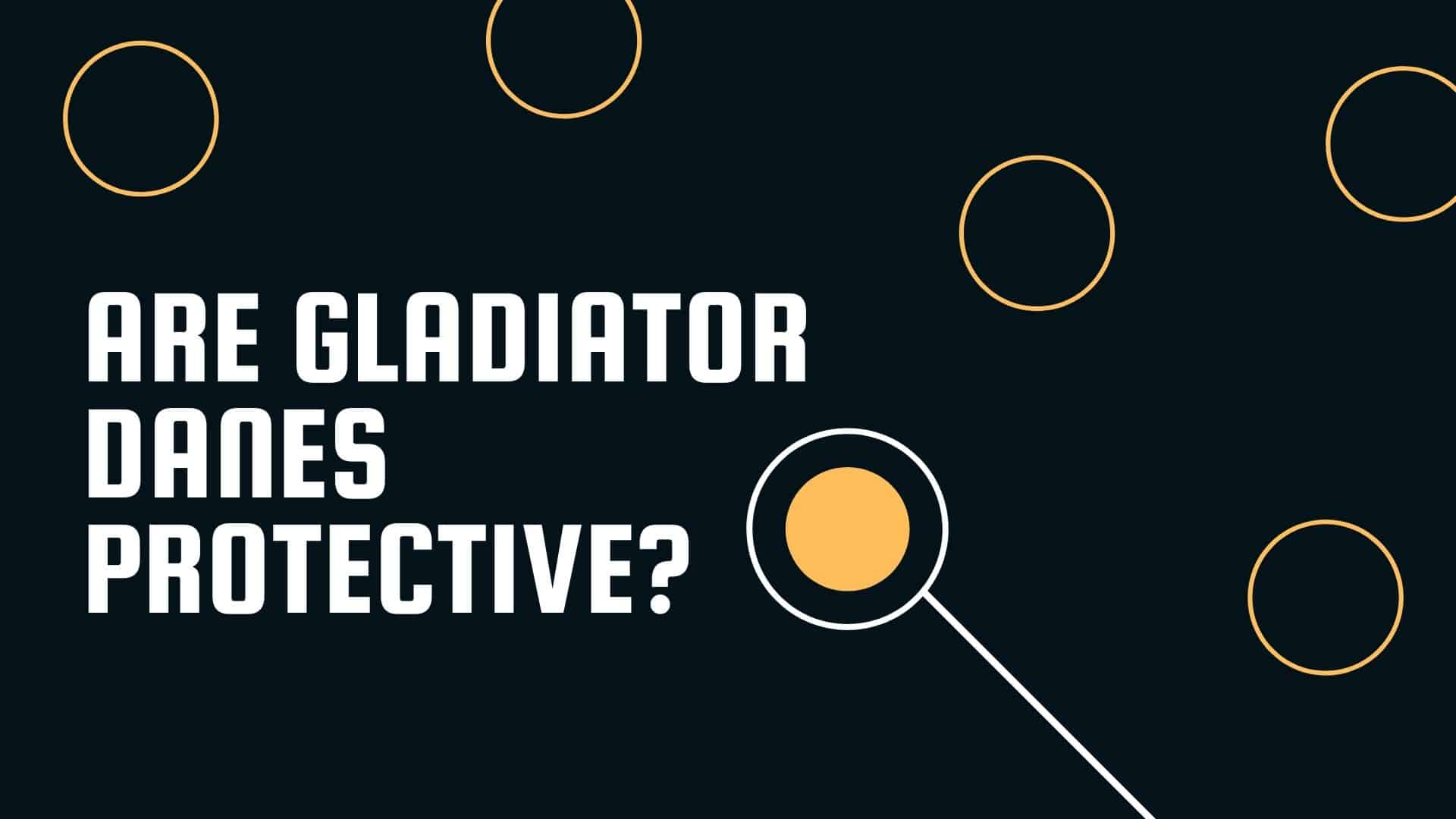“This post contains affiliate links, and I will be compensated if you make a purchase after clicking on my links.”
Last Updated on July 26, 2024
A Gladiator Dane is a dog like no other – this cross between the world’s heaviest dog breed and one of the tallest breed will ensure their presence is known in every room they walk in, thanks to their enormously majestic presence.
The Gladiator Dane, a cross between the Great Dane and English Mastiff dog breeds is known by many names – The Daniff, Mastidane, English Daniff, and Great Daniff.
With a Gladiator Dane, you get a dog that is at both ends of the spectrum – their physical characteristics will definitely intimidate you, but their personality will win you over with how protective, gentle, lovable, and loyal they are.
Mesmerized just yet? This is just the tip of the iceberg! If you’d like to know more about these beautiful and enormous dogs, then continue reading below!
Get To Know A Gladiator Dane’s Parent Breeds
The Gladiator Danes’ parent breeds have distinguishable and prominent historical backgrounds. So, before we dig into the Gladiator Dane, let’s first meet its enormously beautiful parents: the Great Dane and the English Mastiff.
Great Dane
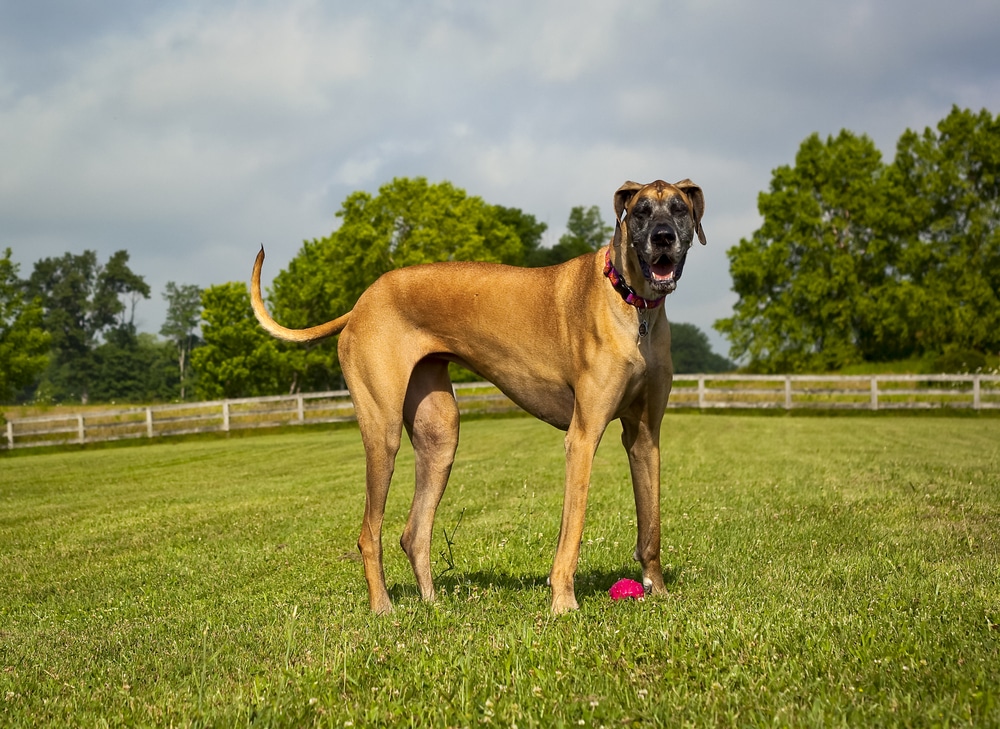
The Apollo of Dogs – a moniker fit for the tall and majestic Great Dane. These dogs, while intimidating in size, are known for their gentle temperament.
These dogs are actually closely related to the English Mastiff breed. Because like other “purebred” dogs today, the breed was once a “crossbreed” from long time ago.
The Germans bred the Great Danes over 400 years ago. And the Great Dane breed came to be from a mix of three different breeds: the English Mastiff, Greyhound, and Irish Wolfhound.
They have the muscles and strength of the Mastiff, the size of the Irish Wolfhound, and the agility of the Greyhounds – the perfect mix to create a dog for the purpose of hunting wild boars.
Today, Great Danes have evolved to become ideal companion and guard dogs, thanks to their gentle, loyal, protective, and amendable temperament.
English Mastiff
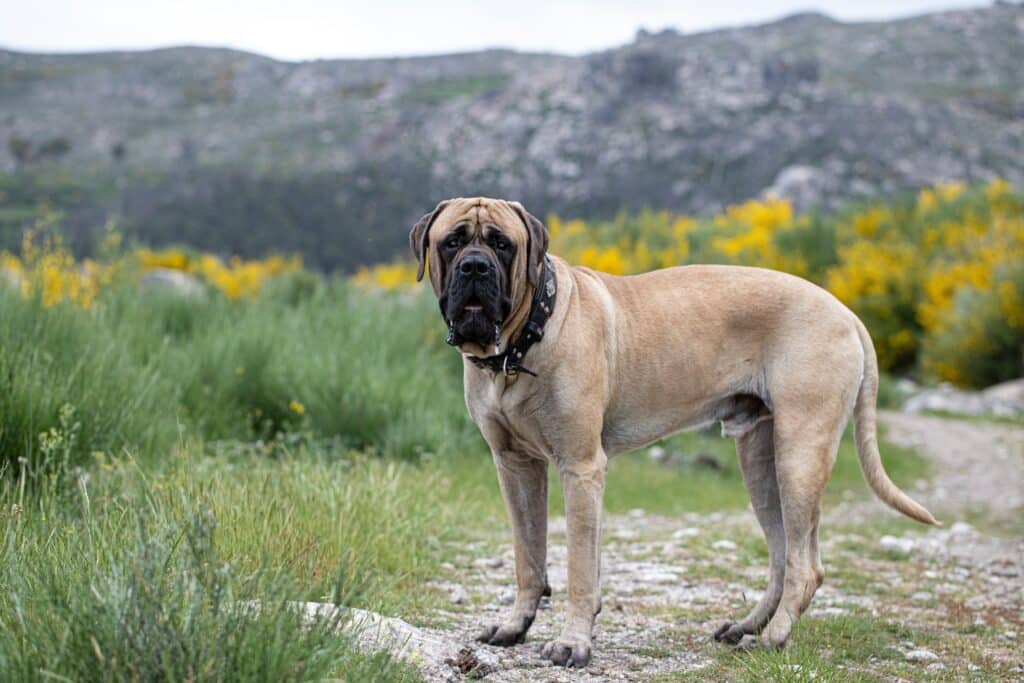
The English Mastiff, or simply the Mastiff, is the heaviest dog breed in the world. And they have a rich history that spans thousands of years.
The Mastiff is believed to be found in European and Asian records dating back to 3000 BCE. Ancient Romans made these dogs fight in the Coliseum with lions, bears, tigers, bulls, other dogs, and even human gladiators.
Interestingly, throughout the years, the Mastiff became known to be a loyal, protective, and strong dog that knows when to be docile.
Such temperament was exhibited when the story of the English knight Sir Piers Legh from the early 1400s came to be. According to the story, a female Mastiff stood over him and protected him for hours in a battlefield, even prevented French soldiers from taking the knight as their prisoner.
Today, like Great Danes, Mastiffs are known to be “gentle giants” for their patient, loving, and warm temperament.
Gladiator Dane Appearance
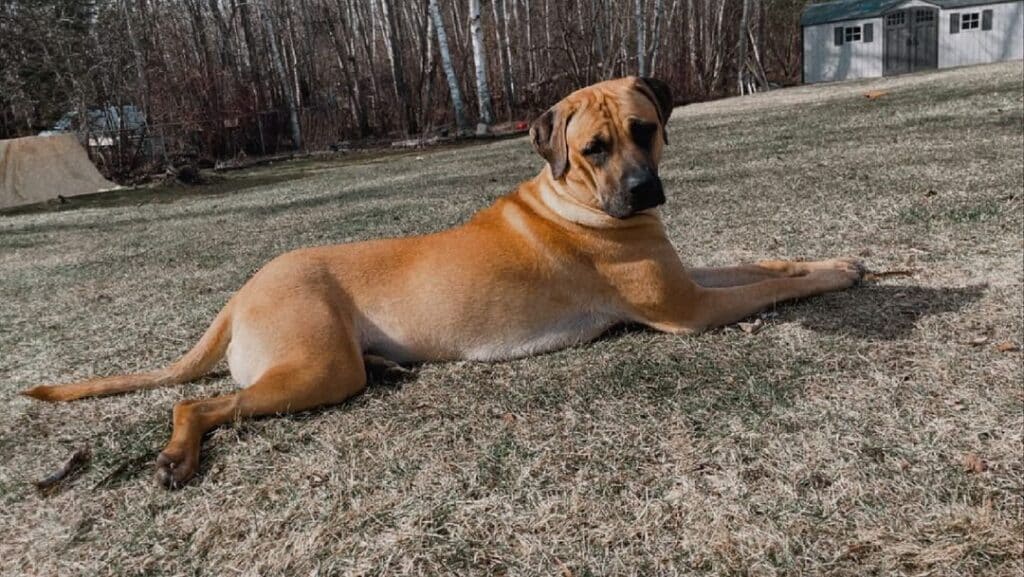
Gladiator Danes are known to be first generation hybrids between the Great Dane and English Mastiff. This means that they inherit 50-50% genes from both of their parents.
Gladiator Danes usually take after their Great Dane parent’s floppy ears, elongated muzzle, and a long and lean body. And then they take after their Mastiff parent’s muscular and somewhat broad build.
However, there are still Gladiator Danes with different percentages of parental breeds. There can still be a probability of it being a 60-40% mix or a 70-30% mix.
And they can either resemble their Great Dane parent’s overall physique, or be a little bit rounder and thicker like their Mastiff parent.
And while there is no telling which of the parent breeds’ will prevail in every puppy, there is one thing that is certain – they will grow up into massive dogs! But that is to be expected, being the offspring of two giant dog breeds.
As a matter of fact, a male Gladiator Dane can weigh around 115 to 150 pounds and can grow to a height of 30 to 35 inches. Meanwhile, a female Gladiator Dane can weigh around 115 to 125 pounds and can grow to a height of 23 to 28 inches.
Furthermore, Gladiator Danes have short coats that come in a variety of colors. Typically, they come in colors such as fawn, brindle, and apricot. And since their Great Dane parent comes in coat patterns, they can inherit this and can be born with a merle or harlequin coat.
While they have short hair, they do shed a good amount of hair. Can’t really blame them when they’re such big dogs!
Gladiator Dane Breed History
Unlike other crossbreeds with Great Danes, the Gladiate Dane breed is relatively new. As they’re believed to have originate in the United States in the late 20th century and have only been around for about 15 years.
Despite being a relatively new crossbreed, Gladiator Danes are quickly growing in popularity among dog lovers and owners alike.
And given its hybrid pedigree, the Gladiator Dane breed is not a full recognized breed by the American Kennel Club (AKC). However, it is a registered designer dog breed under the following canine clubs and organizations:
- A.C.H.C. (American Canine Hybrid Club)
- D.B.R. (Designer Breed Registry)
- D.D.K.C. (Designer Dogs Kennel Club)
- D.K.C. (Daniff Kennel Club)
- D.R.A. (the Dog Registry of America, Inc.)
- I.D.C.R. (International Designer Canine Registry)
Gladiator Dane Personality
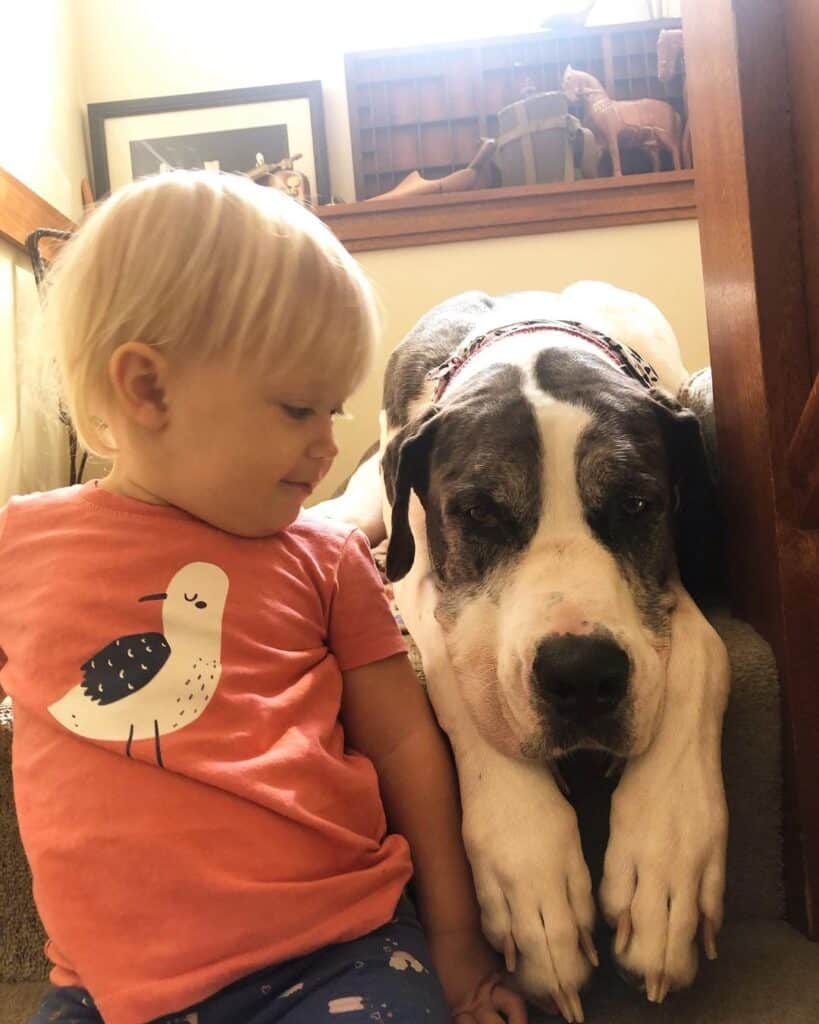
baskervillethehound
As a cross between two intimidating yet gentle breeds, Gladiator Danes have personalities as big as their size!
While people, especially children, will find them daunting, Gladiator Danes are the ultimate ‘gentle giants’ and are actually great with children – they are big bundles of joy, are lovable, and patient.
However, this is not a reason to leave them alone and unsupervised with children. Given their size, paired with their clumsy and enthusiastic attitude, leaving them unattended with small hoomans is a no, no!
These dogs are also friendly and easy-going. So, (with proper socialization), they can be well-behaved dogs around other people and will be able to get along with other animals and pets in the house.
And while they are naturally intelligent and learn well, they can be quite challenging to train because they can also be quite stubborn. So, being patient with them is a must, and will pay off in the long run!
But most importantly, they are loyal and will protect their owners when need be. And they do not bark unless they really need to. So, with their sheer size and protective nature, they make amazing watch dogs.
Overall, Gladiator Danes have amazing personality traits that make them popular family companions and watchdogs. So, there is no question why they’re a popular breed.
Taking Care Of A Gladiator Dane
Like any other dog breed, Gladiator Danes entail specific care requirements to ensure you can maintain their over-all health.
Training
The Gladiator Dane is a dog that needs training due to their size and inherent protective instincts. While these are great traits as a watchdog, they can pose a problem if you want a Gladiator Dane as a family companion.
Socialization and obedience training are among the most important forms of training that a Gladiator Dane must undergo. This will help curb aggression and turn them into well-rounded and behaved dogs.
Furthermore, training must be done when the Gladiator Dane is still a puppy or as soon as you bring one home. This is because they still aren’t as stubborn as when they are adults and they are still building their characteristics, which you can positively contribute to, with proper training.
To make training a bit easier, you can use positive reinforcement when training a Gladiator Dane, since they can be eager to please.
The key to training a Gladiator Dane is persistence and patience! While it will take time, successful training will reward you with a well-behaved dog.
Socializing a Gladiator Dane
Socializing is crucial for a dog to inhibit aggression towards people and other animals. Particularly, if you own a huge dog with a natural inclination towards protection, socializing is an integral part of training the dog.
Frequent visits to dog parks, regular exposure and meeting people, including friends, will help the dog be socialized. Such activities for a Gladiator Dane will help it realize the presence of a ‘no threat zone’ in people around it.
Physical Activities And Exercise
Gladiator Danes are fairly active dogs so they require plenty of exercise to keep them happy and healthy. Furthermore, they can be prone to obesity, so exercise is really a must!
A lack of physical activities and exercise such as play time and daily walking can make them overweight, which is not ideal for their health.
Since they are big dogs, they will do best in a home with a big yard where they can play and run around. Or you can always take them to a dog park to exercise and socialize them (talk about killing two birds with one stone, right?).
And don’t forget about their mental stimulation! Making sure they have enough toys to play with while indoors will keep them happy and occupied.
Diet
A Gladiator Dane will need high-quality dog food that is specifically formulated for large and giant dog breeds, with protein as its primary ingredient.
And while they require more food than small and medium-sized dogs, overfeeding them is a big no no. These dogs can easily become obese, so overfeeding them along with not giving them plenty of exercise will lead to serious health problems.
Furthermore, they must not be fed one huge meal a day, because this can cause bloat. As puppies, their meal should be divided into four small meals a day. And as adults, three meals a day will be enough.
Also, a raw diet can be a good food source or diet. As it provides a dog a complete, and well-balanced diet. If your dog is allergic to some ingredients in dry dog food, switching to a raw diet may help.
Be careful though! When switching to a raw diet, you have to do it accordingly. For puppies, a rapid switch to raw food will have little to no problem. As for adults, it is better to do a gradual switch, since a rapid switch can cause digestive distress.
Life Span
The Gladiator Dane has an average lifespan of 8 to 12 years. While their life expectancy isn’t as long as other breeds, this is still longer than both of its parents’ life expectancy, which is generally about 6 to 10 years.
Considering their intimidating size, a life expectancy of 12 years isn’t all that bad. Of course, not all Gladiator Danes will reach this age all on their own since a lot of factors can affect their age – like their overall lifestyle, diet, exercise, health problems, etc.
Potential Health Risks
Like other crossbreeds, Gladiator Danes tend to be healthy, but of course, like all other dogs, can be prone to some health conditions.
Some of the most common health problems that Gladiator Danes are predisposed to are:
1. Bloat
Bloat is a serious and life-threatening condition that Great Danes are predisposed to. This is when a dog’s stomach fills with air like a balloon. And when left unattended, the stomach can twist in itself, block the entrance and exit of the stomach, and can affect the blood circulation to other organs, like the heart.
While its primary cause is unknown, dogs with bloat tend to be those that eat rapidly or a lot of food in a short amount of time.
Signs of bloat
Given the dangerous nature of bloat, it is important to know the different signs and symptoms of the condition:
- Pacing
- Restlessness and anxiousness
- Retching (trying to vomit)
- A swollen and hard stomach
- Drooling
- Pale gums
- Labored breathing
- Rapid heart and pulse rate
- Whimpering
Prevention
Some of the most agreed upon bloat prevention ways for large breed dogs like Gladiator Danes are:
- Feeding your dog smaller meal portions instead of one large meal.
- Avoiding any sort of physical activity or exercise right before and after a meal.
- If your dog is a fast eater, buying slow feeder bowls/devices will help.
- Having a relaxed, contented and placid disposition can also lessen the danger of bloat for your Great Dane.
2. Hip Dysplasia
Hip dysplasia is a joint disorder present mainly in large breed canines. And both the Mastiff and Great Dane breed are predisposed to this problem.
Hip dysplasia is when the ball and socket of the dog’s hip joint do not fit or develop properly, so it rubs or grinds instead of sliding smoothly. This can restrict a dog’s movement and can be very painful for them.
Signs
The following are the signs and symptoms of hip dysplasia in dogs:
- Pain or reluctance during physical activity
- Discomfort or stiffness in getting up
- Passiveness
- Refusal to rise from an initial position
- Walking or running with stiffness
- Lack of muscle tone in hind limbs or back legs
- Swaying
- Decreased activity
Prevention
You can take the following measures to help lower the chances of hip dysplasia in a Gladiator Dane:
- Feeding your dog from an early age an appropriate diet for healthy bone and joint development.
- Provide appropriate physical activities and exercise for your dog as it grows up.
- Get your dog from a responsible breeder or get the dog screened to see if the dog has hereditary hip dysplasia.
3. Osteosarcoma
Osteosarcoma, commonly known as bone cancer, is another disease that both Great Danes and Mastiffs are prone to. The cancer usually starts on the dog’s arm and leg bones and then quickly spreads to the rest of the dog’s skeletal system.
Signs
Osteosarcoma manifests itself in dogs with the following signs:
- Swelling or lumps growing on a limb
- Pain in joints or bones
- Lameness
- Loss of appetite
- Fatigue
- Reluctance to move and/or exercise
4. Obesity
The Gladiator Dane can be prone to obesity because of their Mastiff parent’s predisposition to it. This can be a serious problem because it can cause or worsen other serious problems such as joint problems, digestive disorders, heart disease, and many more.
While it causes serious problems, it is also easily preventable. You can easily assess if your dog’s weight is still healthy or if they’re at risk of obesity with this “hand test”:
- If you can feel the ribs of the dog like the the back of your hand, then your dog is in great condition.
- If you can feel the ribs of the dog like your knuckles or stick out like knuckles, then your dog is too thin.
- If you can feel the ribs of the dog like the palm of your hand, then your dog is overweight.
If your dog is overweight, you have to start adjusting their diet to help them lose weight. This can be achieved by using a specific diet, portion, and meal frequency.
Furthermore, limiting their treats and making sure they get the right amount of exercise will help them lose weight.
The Cost Of A Gladiator Dane
The price of a Gladiator Dane is largely determined by the location and the breeder you are buying from. But generally, the cost ranges from $600 to $800.
Although there are some expensive breeders that sell Gladiator Dane puppies at a higher price, like $1000.
Adoption And Buying Tips For Gladiator Danes
Getting a dog must be a well-informed decision, because it takes a lot of effort and money to raise one.
If you have decided to get a Gladiator Dane, then here are a few tips for you:
- If you are buying, make sure to get it from a reputable breeder. These breeders adhere to moral breeding norms, so you can ensure that the dog you’re getting is healthy.
- Do NOT buy from puppy mills or breeders that do not follow breeding principles. Most often than not, these dogs are not healthy.
- If you can, adopt, don’t shop!
Conclusion
Indeed, Gladiator Danes are big bundles of joy! And with their personality and characteristics, paired with their intimidating size, it’s not hard to see why they’ve been becoming increasingly popular.
And if you ever decide to get one for yourself, make sure to do your research so you can live with the perfect companion while also making sure that your dog gets to live a happy, healthy, and fulfilled life.
